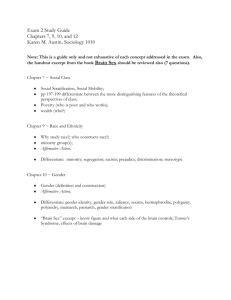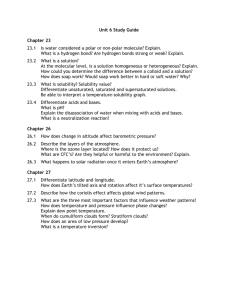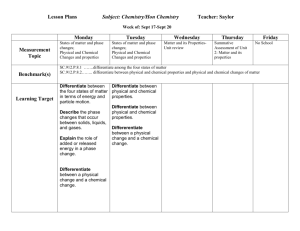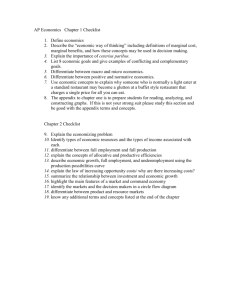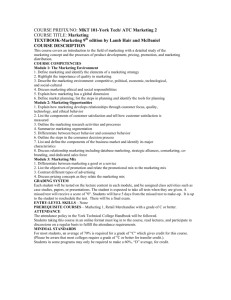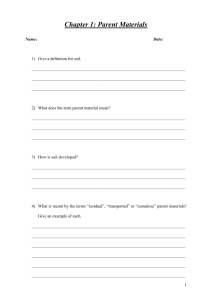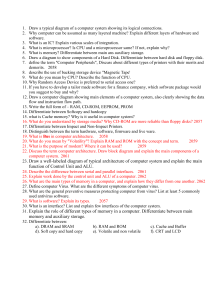MARKETING homework questions
advertisement
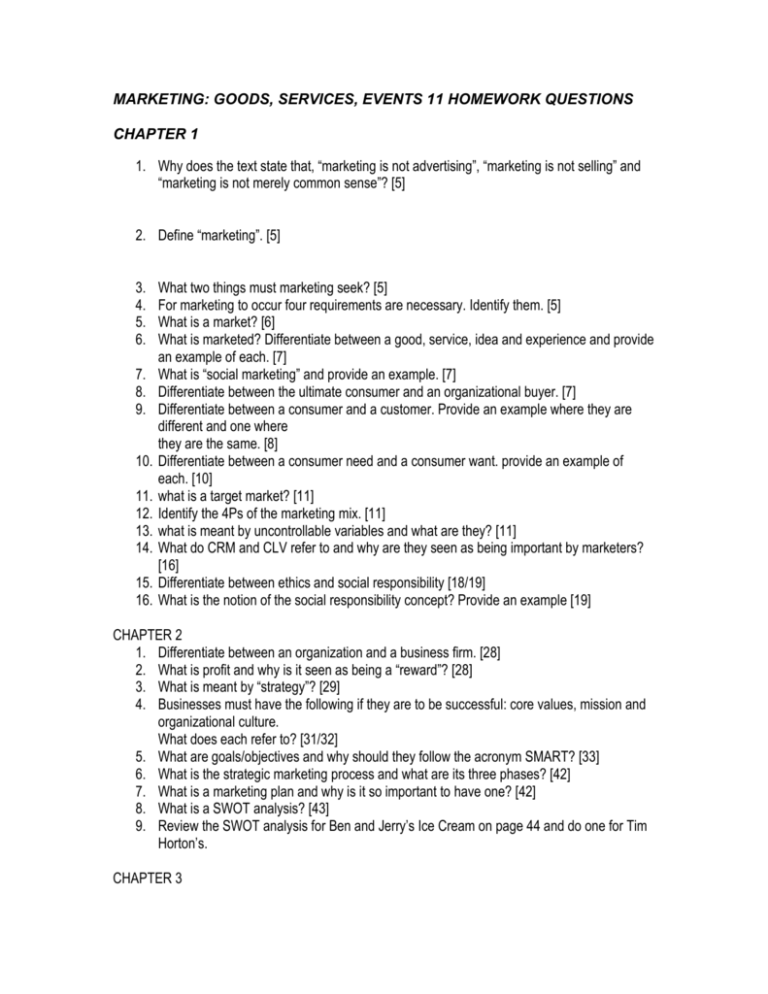
MARKETING: GOODS, SERVICES, EVENTS 11 HOMEWORK QUESTIONS CHAPTER 1 1. Why does the text state that, “marketing is not advertising”, “marketing is not selling” and “marketing is not merely common sense”? [5] 2. Define “marketing”. [5] 3. 4. 5. 6. 7. 8. 9. 10. 11. 12. 13. 14. 15. 16. What two things must marketing seek? [5] For marketing to occur four requirements are necessary. Identify them. [5] What is a market? [6] What is marketed? Differentiate between a good, service, idea and experience and provide an example of each. [7] What is “social marketing” and provide an example. [7] Differentiate between the ultimate consumer and an organizational buyer. [7] Differentiate between a consumer and a customer. Provide an example where they are different and one where they are the same. [8] Differentiate between a consumer need and a consumer want. provide an example of each. [10] what is a target market? [11] Identify the 4Ps of the marketing mix. [11] what is meant by uncontrollable variables and what are they? [11] What do CRM and CLV refer to and why are they seen as being important by marketers? [16] Differentiate between ethics and social responsibility [18/19] What is the notion of the social responsibility concept? Provide an example [19] CHAPTER 2 1. Differentiate between an organization and a business firm. [28] 2. What is profit and why is it seen as being a “reward”? [28] 3. What is meant by “strategy”? [29] 4. Businesses must have the following if they are to be successful: core values, mission and organizational culture. What does each refer to? [31/32] 5. What are goals/objectives and why should they follow the acronym SMART? [33] 6. What is the strategic marketing process and what are its three phases? [42] 7. What is a marketing plan and why is it so important to have one? [42] 8. What is a SWOT analysis? [43] 9. Review the SWOT analysis for Ben and Jerry’s Ice Cream on page 44 and do one for Tim Horton’s. CHAPTER 3 1. What is “environmental scanning” and why should businesses engage in it? [76] 2. Given Figure 3-2 on page 78 be aware of the trends in each environmental force area for Canada. 3. Define social forces, demographics, baby boomers, Generation X, Generation Y, blended family and ethnic marketing. [78-81] 4. What are “value consciousness” and “eco-consciousness” and how do they impact on marketing? [83] 5. Differentiate between gross income, disposable income and discretionary income. [85] 6. How has technology most recently impacted on marketing? [86-88] 7. What is UGC and why is it so important to marketers? [88] CHAPTER 4 1. What is meant by the “ethics of exchange”? Provide the various “rights” that consumers should expect. [106] 2. What is meant by the “ethics of competition” and differentiate between economic espionage and bribery. [106-107] 3. What is a “whistleblower”? [108] 4. Differentiate between the three concepts of social responsibility that face a company. [110111] 5. What is “cause marketing? Provide an example. [112] 6. What is meant by “sustainable development”? Why would a company want to engage in such a practice? [112] 7. Read the Starbucks case study on page 117-119 and answer questions 1 and 2 on page 119. CHAPTER 5 1. The purchase decision process has five distinct stages. Identify each stage and briefly outline what happens in each. [122-124] 2. What is “cognitive dissonance”? Have you ever experienced it? [124] 3. What is mean by “motivation” in the buying decision? [127] 4. Differentiate between the following hierarchy of needs and provide an example of each: physiological, safety, social, personal and self achievement. [128] 5. What is mean by “perception” and how does it differ from person to person? [129] 6. How do marketers deal with “perceived risk” of customers? [130-131] 7. What are the four variables central to behavioural learning for consumers? Provide an example of each. [131] 8. What is “brand loyalty” and how is it used in the purchasing decision process? [131] 9. What is meant by psychographics? [133] 10. What is “opinion leadership” and how is it used by marketing? [134] 11. What does “word of mouth” refer to and why is it so important as a marketing tool? [134] 12. What is “buzz marketing” and “viral marketing”? Provide an example of each. [135] 13. What are reference groups and what is their importance in marketing? Differentiate between membership group, aspiration group and dissociative group. [136] 14. What is meant by “family life cycle” and how do marketers target each phase? [136-137] CHAPTER 8 1. Define “market research”. [202] Differentiate between “reliability” and “validity” as applied to market research. [204] 2. Identify the four basic stages of market research. [204] 3. Differentiate between primary and secondary data and provide one advantage and one disadvantage of each. [206] 4. What is a focus group? [207] 5. What is a survey and what are the various ways that it can be carried out? [209] Review Figure 8-3 on page 210 for a comparison of the various methods. 6. Differentiate between an “open-ended” and a “closed-end” question. [210] 7. Review Figure 8-4 on page 211 to see the typical problems in wording survey questions. Be aware of the types of problems and examples of each. 8. What is a sample and why is it used by marketers? [217] 11. What is “data mining” and how is it used by marketers? [222] CHAPTER 9 1. How did GM’s marketing vs. Ford’s marketing differ and what did it prove in the early part of the 1900s? [230] 2. What are market segments and what are the two key characteristics defining a market segment. [231] 3. What is product differentiation and how is it used by marketers? [231] 4. Differentiate between geographic, demographic, psychographic and behavioural segmentation? [235-237] Use Figure 9-4 on page 236 for info. 5. What is the 80/20 rule? How do marketers use this knowledge? [237] 6. What are the five criteria that are utilized in selecting the market segment you should target? [240-241] 7. What is meant by “product positioning” and “product repositioning”? [243] 8. Differentiate between the two main approaches to positioning a new product in the market. [243] CHAPTER 10 1. Differentiate between product, product line and product mix. [254-255] 2. Differentiate between consumer goods and business goods. Use a tomato as an example to show that it can be both under differing circumstances. [255] 3. Differentiate between non-durable goods, durable goods and services and provide two examples of each. [255] 4. Identify the four types of consumer goods and provide two examples of each. [256] 5. Identify the two types of business goods. [257] 6. What is meant by a “derived good”? [257] 7. What are the main reasons new products fail? [261-263] 8. Outline the various stages a firm should go through when introducing a new product. For each stage provide a brief description of what happens. [264-273] CHAPTER 11 1. What is meant by the product life cycle? [281] 2. Provide a brief description of each stage of the product life cycle. [282-284] 3. Differentiate between a “skimming strategy” and a “penetrating price strategy”. [282] 4. Differentiate between “deletion” and “harvesting” strategies. [284] 5. Differentiate between the shape of the product life cycle for a “high-learning” product vs. that of a “low-learning” product. [284] 6. What is meant by “product modification” and what role does it play in the life cycle of a product? [287] 7. What do you think “rebirth” refers to in the product life cycle? [not in text, think about it] 8. Differentiate about branding, brand name, trade name and trademark. Provide examples of each. [290-291] 9. What is meant by “brand personality”? Provide two examples. [291] 10. What is meant by “brand equity” and how can it be created? [291-292] 11. What is “brand licensing” and how can brand equity help? Provide two examples. [294] 12. What are the five criteria that should be considered when selecting a good brand name? [294-297] 13. Outline what each one of the following branding strategies refers to and provide an example of each: multiproduct branding, multibranding, co-branding, private branding and mixed branding [295-298] 14. What is a warranty and why is it important to both consumers and producers? [302] CHAPTER 12 1. Define “services” and provide the four unique elements that set them apart from tangible goods. [309] 2. Provide a brief description of the 4Is of service. [310-311] 3. What is meant by “gap analysis” in the post-purchase evaluation phase of a service? [315316] CHAPTER 13 1. What is price and what are the steps in setting price? [332-334] See Figure 13-2 on page 334 for help. 2. Other than price, name three other factors in determining demand. [339] 3. Identify the four conditions that makes a “skimming” price an effective strategy. [343] 4. Identify the various conditions that favour a “penetration” pricing strategy. [343] 5. What is meant by “prestige pricing”? Provide an example. [344] 6. Provide an example of “price lining” and why would a company do this? [344] 7. Why do retailers engage in “odd-even pricing”? [345] 8. What is “bundle pricing” and why do companies engage in it? [345] 9. Cost-oriented approaches to pricing include: standard markup, cost-plus and experience curve pricing. Differentiate between each. [346] 10. Competition-oriented approaches to pricing include: customary, above, at or below market price. What is meant by each and why is each done? [347-348] 11. There are four kinds of discounts. Identify each one and provide a brief explanation of why they are made. [352-353] 12. What is meant by “horizontal price-fixing” and “predatory pricing” and why are these practices illegal and against the Canadian Competition Act? [354-355] CHAPTER 14 1. What is meant by the “marketing channel”? [370] 2. What are the three basic functions performed by intermediaries? [370-372] 3. Differentiate between a “direct channel” and an “indirect channel”. Provide an example of each. [373] 4. Differentiate between a “merchant wholesaler” and an “agent” and “broker”. [376-377] 5. What is meant by “inventory”? [394] 6. Why is the JIT concept so popular with both producers and retailers? [395] CHAPTER 15 1. What does “retailing” refer to? [402] 2. Retailers are classified according to form of ownership, level of service and merchandise line. For each way identify the various subgroups and provide a one line description and example of each. [403-406] 3. Other than “brick and mortar” retailers provide four other types of retailing. [407-409] CHAPTER 16 1. Define “advertising”. [431] 2. Differentiate between “push” and “pull” strategies by manufacturers. [439] CHAPTER 17 1. Using Figure 17-3, outline the advantages and disadvantages of each of the various advertising mediums. [464]

